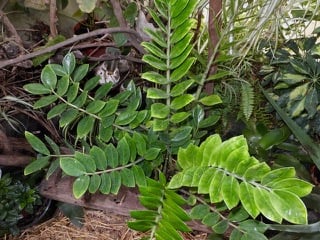
Often your glasshouse or conservatory collection will have a theme be it edible, scented or just all orange flowers. I have had several queries recently on plants typical of when dinosaurs ruled the Earth. An interesting question as if you want actual survivors from that period then the selection is rather limited and of course contains few of our more modern flowering plants. To say little of the cost and inconvenience of running a steam drenched tropical hothouse?
More practical is to choose those plants that will give the right ambience so one can imagine a wee dinosaur poking its head out from amongst them. So what are the best candidates for your own Jurassic Park? Well luxurious ferns are mandatory, with some compact palms and numerous other foliage plants. Foremost amongst these ought to be Zamioculcas zamiifolia which does not just look like a prehistoric plant but even sounds like a prehistoric monster, my children call it the Stegosaurus plant from it’s strange pinnate foliage.
Zamioculcas (sorry no common name so I suggest we adopt the Stegosaurus plant as its name) is one of the Aroid family and has a rhizomatous root system similar to Monstera , Anthurium and Alocasia. From this springs a birds nest of fleshy arching pinnate shoots with neat pairs of small dark waxy leaves aligned along them. Every so often the plant may produce from the base a stout spadix enclosed by a pale green boat shaped spathe typical of the Arum family but this is only a bonus, the real value is in the nest of ‘prehistoric’ leaves.
This vegetable Stegosaurus comes from Zanzibar and Tropical Africa where it is found in dry scrublands from the coast up to 3,000 feet, usually in dappled shade. This means it is best kept happy in a well ventilated heated greenhouse (17°C at night -28°C day) with the biggest danger being frost and cold damp humid conditions which can lead to leaf drop or rot. Thus, as with pineapples, the compost is best kept damp in the growing season and nearly bone dry through the colder months. Only warm rainwater should be applied and the roots should never be kept wet standing in a saucer but stood where the pot can drain freely.
Zamioculcas is only comfortable in a free draining compost of leaf mould and coarse sand and fine composts that pack down should be avoided. Indeed any addition that improves drainage will be of assistance such as crushed brick, gravel or granite chippings, with a little well rotted manure (or pelleted processed manure) for long term fertility.
Though theoretically this could be grown from seed I’ve never heard of it being offered so a small plant must be obtained which will slowly grow to some yards across. With the exception of a variegated version there are few varieties or species for the collector. (And I’ve no idea where you get a matching dinosaur from?)










